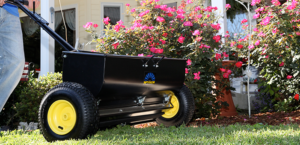When it comes to seeding your yard, one of the most commonly asked questions is ‘Which lawn spreader is best for my job?’ Whether it be a broadcast spreader, drop spreader, or a handheld spreader, the right spreader will prevent you from wasting materials while also improving results. Here are some factors that you should consider:
- Size of the yard/area that you will need to cover
- How big the hopper needs to be (amount of material you’ll be spreading)
- The material you are going to be spreading
- The number of tight spots and obstacles
- Is the area open or are you going to need a precise spread?
- How much time are you willing to spend?
- How much money are you willing to spend?
Types of lawn spreaders
Broadcast Spreaders
Broadcast spreaders “broadcast” fertilizer in a fan-like pattern. Most broadcast spreaders have a dial which allows the material to be dispensed at various rates. However, the spread width depends on the rate that you are walking. Broadcast spreaders are built to handle many different types of products, such as seed, fertilizer, sand, and ice melt. One downfall to broadcast spreaders is that it is hard to control where the material lands, making it difficult to avoid walkways, driveways, and gardens. They can come in a Push or Pull design, with a push spreader being a manual job while a pull-behind spreader can be towed by a tractor or ATV.
Broadcast spreader considerations:
- Built for medium to large sized lawns
- Large hopper capacity
- Hopper sizes range from 23-150 pounds
- Distributes material quickly
- More ground is covered in less time
- Lacks precision
- Side deflectors as accessories
- They are typically walk-behind
- Prices range from $35 – $700
 Drop Spreaders
Drop Spreaders
Drop spreaders have precise accuracy as they drop material straight down. Similar to the push-behind broadcast spreader, the rate at which you walk impacts the spread width. Due to material only dropping between the tires, you must be sure to overlap wheel paths on each pass.
Drop spreader considerations:
- Built for small to medium sized lawns
- Large hopper capacity
- Hopper sizes range from 75-175 pounds
- Provides a precise spread, ideal for tight spots
- They cover less ground than broadcast spreaders, but more than handhelds
- Easy to operate
- Limits product waste
- Comes in both tow-behind and push models
- Prices range from $80 – $600
Handheld Spreaders
Handheld spreaders are most commonly used for smaller lawns or small areas, as they are the most portable and the easiest to use out of all spreaders. Like the broadcast spreader, handheld spreaders also fan material but over a much smaller area. They typically have a dial that controls the flow of material and are operated with a hand crank.
Handheld spreader considerations:
- Built for small lawns or small areas
- Holds less material
- Hopper size is typically 5 pounds
- The material doesn’t spread evenly
- More precision than the broadcast spreader, but less than the drop spreader
- Easy to use
- Easy storage

- Very affordable
Tow-behind Spreaders
If you have a large lawn and a riding lawnmower, then a tow-behind spreader is always an option. These spreaders can be found in both broadcast spreader and drop spreader models. Although tow-behind spreaders have the same advantages and disadvantages as the push models, they save you the effort of having to push a spreader around your lawn.
In conclusion, getting the right tools for the job is the most important step in getting the healthy, green lawn you want this year!



